Podcast: Play in new window | Download (Duration: 36:34 — 43.0MB)
Subscribe: Apple Podcasts | Spotify | Amazon Music | Android | Pandora | iHeartRadio | JioSaavn | Podcast Index | Email | TuneIn | RSS | More
By Davy Crockett
![]()
![]()
Both a podcast episode and a full article
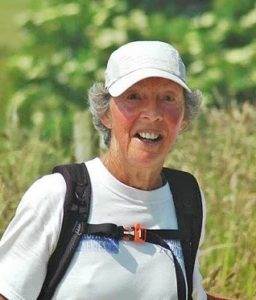

Sandra was the very first person in the world who finished 100 100-milers and the first to reach 200. By the end of July 2021, Sandra Brown, age 72, of England had accomplished a world-best, 208 100-milers, walking and running on tracks, roads, and trails in various event formats. About 160 of her 208 100-milers were accomplished in less than 24 hours, also a world best.
Most 100-milers in the World
Yes, Sandra Brown reached 100 miles 200+ times in organized events, more than anyone in the world. Ed Ettinghausen (The Jester) has been working very hard to catch up and exceed that number. (He passed that number in 2021).
The World’s Greatest
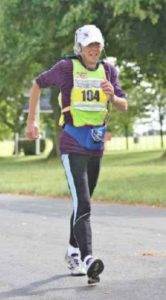

Her 208 100-milers came in several different types of walking and running events on tracks, roads, and trails. These types of events will be described in this article. She is the holder of current world records and it is time that the ultrarunning community learn about Sandra and her amazing accomplishments.
Also on the100x100 list is Sandra’s husband, world-class runner and walker Richard Brown, who delights in being overshadowed at times by Sandra’s accomplishments. They are inseparable and have been married for nearly 50 years. Richard has finished about 140 100+ mile events.
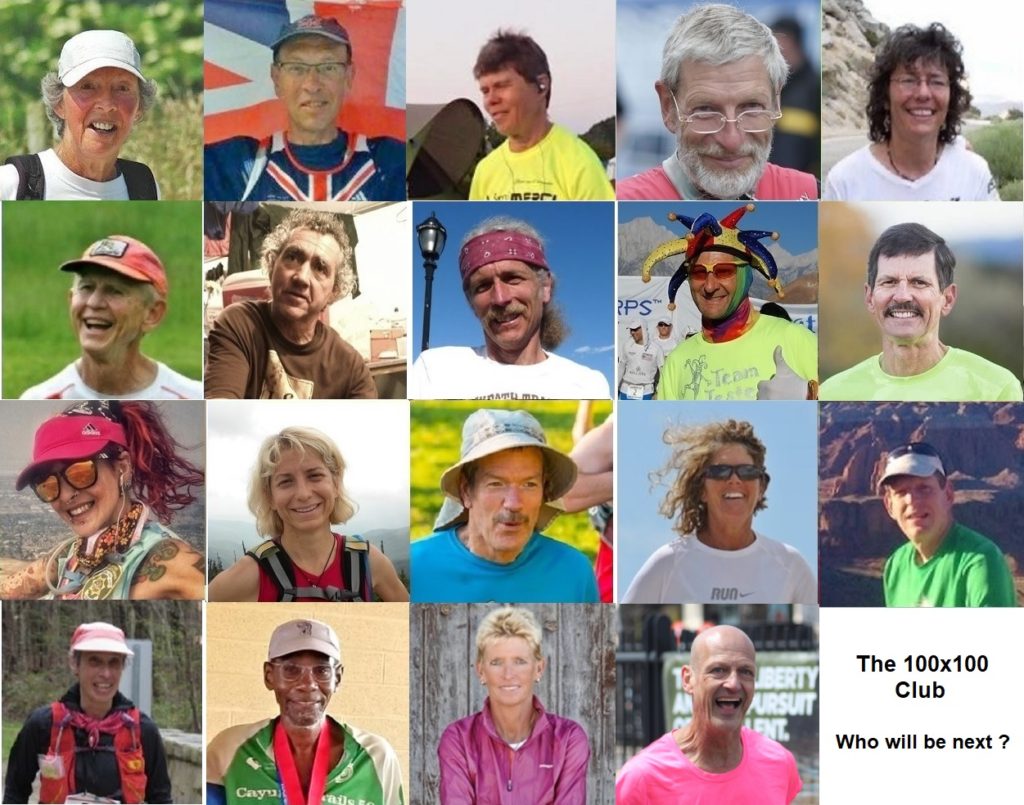

Also read about all these 19 athletes.
Walking and Running
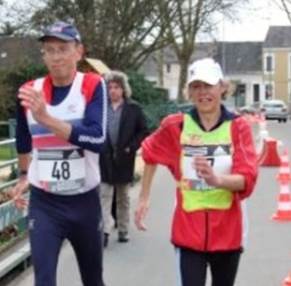

Among her 208 100s, Sandra has completed about 130 100-milers in events that were judged with racewalking rules. But she also completed 100 miles in more than 30 running events and usually she finished at the top. Other 100s were walking events where you could walk any way you wished to reach 100 miles.
Piling up 100-milers while living in England is very impressive because there are far fewer events compared to the US. Sandra wrote, “I’ve always envied athletes in the USA where there are so many ultra-distance and 100 miles events! In the UK there are now several, mainly off-road, 100s, and a couple of 24-hour events. On the Continent, events are mainly 24 hours, though our Dutch and Belgian friends share our love of 100s.”
Ultra Walking
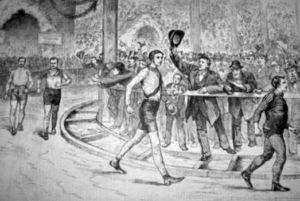

Ultradistance Walking (or Ultra Walking), is the practice of walking in competitions of distances more than the marathon length. They have existed for centuries and truly have roots in 19th century Pedestrianism. “Heel and toe” walking rules were established for these foot races that became a popular wagering venue. Walking competitions were conducted for many distances short, long, ultradistances, and eventually for six days or more.
By 1880 walking rules were further established and amateur competitions started to be held. In general, rules required that the walkers’ back toe could not leave the ground until the heel of the front foot has touched. Rules would change over the years. Accusations of cheating by running, were common and soon “go-as-you-please” events were also established that allowed walking or running.


In 1907 the Southern Counties Road Walking Association was established in London, the first governing body in the world for racewalking. In 1911 it became named the Road Walking Association. This association established national road walking championships and helped promote and keep alive the sport in England. In 1954 the association took over responsibility for track racewalking and was renamed the Race Walking Association (RWA). The RWA established the Long Distance National Championships involving 100 miles or 24 hours fixed-time races.
There are several types of walking events that Richard and Sandra would participate in to reach 100 miles. Most of them include: Racewalk Centurion qualifiers, Race Walk Association (RWA) 100-milers, Long Distance Walker Association Walks, European Point to Points, and Fixed time runs or walks.
Racewalk Centurions


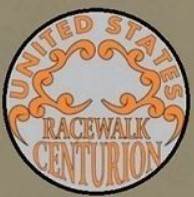

100-milers were also put on by the Race Walking Association (RWA) that were’t Centurion qualifying events. One person described racewalking for 100 miles this way in 1984, “The ‘100’ is among racedom’s cruelest. Punishing. Walk 100 Miles? Come on! Masochists, if so inclined, could have a ball. Self-inflicted pain. Entrants are trapped to their task, prisoners, dependent on handlers who are hopefully doting as the clock circles.”
The Long Distance Walkers Association (LDWA)


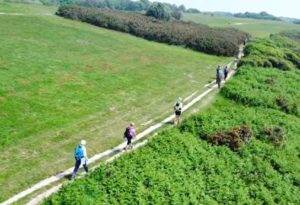

Each walker is required to walk with small packs containing certain items such as the course description, maps, waterproof jacket, clothing layers, hat, gloves, compass, whistle, flashlight, bivi bag, and a first aid kit. Many checkpoints (aid stations) are set up with food and drink between about 5-10 miles apart. At the check points along the course, marshals check the walkers and can pull out anyone over-fatigued or behind schedule.
In 2008, Sandra Brown described a tough LDWA event. “The views were simply fabulous all the way round. This is a National Park with stunning upland scenery, beautiful river valleys, great wildlife, pretty and historical villages and farms. This annual event is across country, almost all off-road, involving 13,000 feet of climb, and 20 pages of route finding instructions. The 48 hour time limit reflects the challenge of the terrain and route-finding. The going was often rough and stony underfoot, causing predictable foot problems.”
European Point to Points
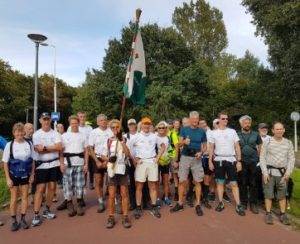

24 hours and multi-day events
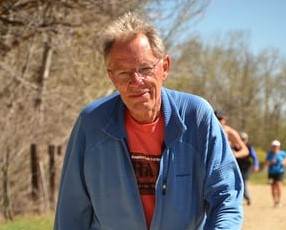

Ultra walkers, just like many ultrarunners, participate in 24-hour and multi-day events such as 48-hours or for six days. Many of these events include runners and walkers, and some mixed events are even sanctioned as formal Centurion qualifiers. In recent years many ultrarunners remember ultra walker Uli Kamm who is a Centurion racewalker. He frequently walked in American fixed-time events, walking with the runners, passing many of them. He wasn’t shy about sharing advice. In a couple races, he chastised me for starting too fast and indeed that was true. But I held on and won both races.
Sandra and Richard Brown
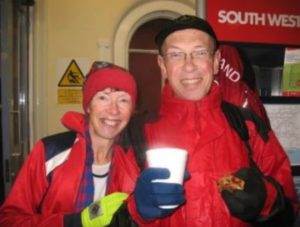

Richard was born in 1946 and raised as an only child in Beckenham, a district of London. His father was a banker. Richard was a talented singer which allowed him to attend the City of London School. Eventually he had interests in sports and became a successful oarsman at Oxford University. It required him to train hard each day, After moving on from rowing, he didn’t really know what to do athletically next because he was useless at ball games. Because he was “useless” in languages with required tests at Oxford, he transferred to UCL.


Richard and Sandra both studied History at UCL. Richard said, “Sandra was only attracted to me because of my rowing [muscles].” They were married in 1970 right after finals and bought a flat in the countryside town of Luton, located northwest of London. Sandra first worked at the British Museum and later worked in the Civil Service (government administration) as did Richard. In their twenties, they both loved spending time outdoors and started to do walks in the country. Five mile walks became ten and then became twenty miles. Sandra joined the Long Distance Walking Association (LDWA) and signed up Richard too. They joined with others to do long walks.
Early Ultra-Distance events
By 1982, when Sandra was 33, they both started entering long distance races. Their first marathon was in 1982, at the Winchester Marathon on a frigid March morning. Richard thought that Sandra had entered them in the half marathon, but no. At the start as they were preparing to run Sandra said, “Oh didn’t I tell you we are in for the full thing.” They finished in under four hours but Richard vowed that he would never do it again.


They quickly entered their first 100-miler later that year, the LDWA Pilgrims Hundred from Guildford to Canterbury along the route taken by many pilgrims to the shrine of the murdered Thomas A’Becket. The event started around noon. They carried haversacks (day packs) and walked and ran in boots.
By the next morning, they reached a breakfast stop at about mile 65. Richard took his time there and said he “slumped down and looked at corn flakes for about two hours which was the maximum amount you were allowed to stay at a checkpoint. Sandra meanwhile was kind of bounding around, ‘well I’ll see you at the finish’ and got up and charged off to the finish. I staggered out with about one minute to go.” He slowly made his way to Canterbury.
By the time Richard got to the finish, Sandra had showered, changed and had been sight-seeing around the famed cathedral. They headed home on the train. Getting off the train at Victoria station was a problem because it was so painful stepping down getting off to the platform. They walked so slowly that they were “overtaken by old grannies pulling their suitcases.” That was their first 100-mile finish. Little did they know what they had unleashed
Racewalk Centurions


Richard and Sandra joined the Surrey Walking Club which had recently started admitting women. Despite the fact that she was already a Centurion, the next year the walking club refused Sandra entry into the event “because women could not and should not do those things.” Richard, however was allowed to enter and also became a Centurion in 1983 with a time of 21:03:49.


They both were hooked on ultra-distance events, especially those over 100 miles. Richard explained, “At ultradistance events we are all in it together. We all know that while to some extent we are competing against each other, we are actually competing against ourselves. We are trying to do the best for ourselves. We know that if we go through a difficult patch one of them will help us. They help because they know in another few hours they will be in difficulty and we will help them. So our aim is to do the best we possibly can. In our sport the comradery, helping each other, is part of what it is about.”
Just a month later, they both ran in their first 24-hour event at Chorley, England. The loop course was in a park on uneven asphalt. Tree roots pushed up in various places that could be tripped on, especially during the night. It also had a hill and sharp corners, not ideal for a 24-hour course. Richard had to stop at mile 97 with a badly swollen ankle but Sandra continued on with a smile on her face. During the last hour Richard came back out using a broomstick for a crutch to reach 100 miles and Sandra reached a staggering 131.1 miles, setting a new world best. Across the Atlantic in America, women greats Marcy Schwam, Sue Ellen Trapp and Sue Medaglia had been increasing the world 24-hour record a few years before, but in 1984 Sandra claimed the record for her own
In 1985 Richard and Sandra ran in their first 48-hour event at the World 48 Hour Championship on a track at Montauban, France. The lineup truly included many of the world best ultrarunners. The world greatest, Yiannis Kouros won and set a mind-blowing world record of 281 miles. American Ray Krolewicz, who would also reach 100×100, placed 3rd, with 225 miles. Richard finished 14th with 187 miles and Sandra in 16th with 169 miles.
Richard continued to improve his 100-mile walking times with 18:33:52 in Holland and eventually reaching 17:00:35 at Leicester in 1988. With 13 100-milers to her name, Sandra took time off 1986 to give birth to their daughter, Victoria and didn’t finish a 100+ mile race for a two-year period. Richard continued on and by the end of 1987 he had 29 100+ finishes to his name.
Ireland End-To-End
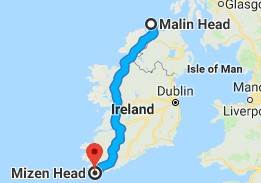

In 1982 the Irish ultra walking champion, John “Paddy” Dowling walked the length of Ireland north to south in 5 days, 22:30 which was recognized as the world record. In April 1988 Paddy started out with Richard on his south to north attempt. But with one support vehicle they became separated too far. Paddy in the rear graciously bowed out. Richard went on to lower the world record to 4 days 12 hours with a distance of 375 miles, a record that stood for many years. It is not included in the count of his 100-milers because it is a solo adventure, not an organized event, but it was verified and is amazing. It was not until 2017 that ultrarunner Eoin Keith lowered the fastest known time to 3 days, 3:47.
Sri Chinmoy 1000 Miles


Just about a month later in May, Richard and Paddy both ran in the third edition of the Sri Chinmoy 1,000 mile race held on a one-mile road loop in Flushing Meadows Park in Queens, New York. It was the was the IAU 1000 mile championship. Also entered was the world greatest, Yiannis Kouros.
Seven of the starters passed 100 miles in the first day with Kouros way out in front with 144 miles. Richard ran very strong in second place. After six days he covered 518 miles, setting a six-day British record. That was an impressive distance, further than both legends Stu Mittleman and Siegfried Bauer reached when they dueled it out in the 1986 version of this race. Richard wrote, “I thought I was doing quite well at 6 days until I realized Yannis Kouros was nearly 100k ahead of me and setting multiple world bests along the way.” Richard reached 1000K (621 miles) in a world age record (45y) of 7 days, 11:40. The record still stood in 2018, 30 years later! Unfortunately Richard’s leg gave out and he stopped at 720 miles in 9.5 days. Yiannis Kouros went on and shattered the world 1,000-mile record with ten days, 10:30.
1988 Lands End to John O’Groats (LEJOG)
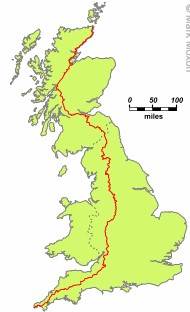

A race was organized north to south in February 1960, with 715 starters. They had to contend with snow, cold rain, sleet and freezing conditions all the way to the finish. The race was won in 15 days, 14:31 along a route of about 891 miles. By 1985 the fastest known time was held by Ken Craig of South Africa who ran it with a time of 12 days 1:59. It was referred to as a record because the Guinness Book of World Records kept track of it if it met verification standards. One run in 1977 of 10 days 3:30 wasn’t verified and there doubts surrounding it, similar to doubts about many of the runs across America over the years that were likely fabricated for fame.
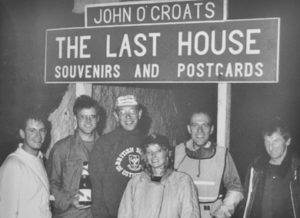

In September 1985, Richard set out with a crew of seven in two campers to lower the LEJOG record. Richard wrote, “After a great start with 90 miles on the first day, 85 on the second and 80 on the third, we made somewhat erratic progress with injuries to my calf muscles as well as the inevitable blisters slowing me sometimes to a painful crawl. In driving rain and a northwesterly wind, we finally however made it and lowered the record to 10 days, 18:23”. While not counted on my list of 100s for Richard because it wasn’t a formally organized event, it was a historic accomplishment to smash the official record.
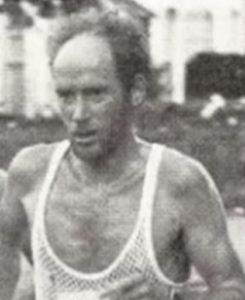

However, one of the greatest ultrarunner ever in the world, Don Ritchie of Scotland, also had his eye on this LEJOG record for some time. In 1987 Ritchie started his attempt, but on day four he suffered a small stress fracture in his tibia, likely caused by the shoes he was running in, and he had to abandon his LEJOG. He had plans in 1988 to try again but because of more injury, he postponed plans for another year. Ritchie finally made his attempt (north to south, a JOGLE) in the spring of 1989 and successfully broke Richard’s record by about three hours with 10 days 15:20.
Richard wrote, “Don’s approach had been very different to mine. I had relied on my walking to maintain a steady and economical pace. I had run down many of the hills to maintain a good daily average to use the different muscles while walking and running deploy. Don by contrast had run three marathons a day at a fairly fast pace. His time on his feet was probably about 10 hours per day against my 17 hours.” Richard sent a card to Richie congratulating him and added that he hoped Ritchie would enjoy the record that he was just borrowing from Richard. Ritchie thought he was kidding. Richard was dead serious that he would get the record back someday.
1990 Milton Keynes 24-hour Championships


In 1990 Richard ran at the historic World 24-hour championships in England at Milton Keynes, on an 890-meter loop in the largest shopping mall in Europe. Cones were put out with long stretches of plastic tape. The surface was hard marble. This race was referred to as “the greatest 24-hour field ever assembled.” World greats, Don Ritchie and Eleanor Adams-Robinson were in the field. There were several elite runners from the United States in the race including, Roy Pirrung, Sue Ellen Trapp, and Randi Bromka.
Richard recalled that mall venue caused some problems. Because of the many glass store fronts, “you nearly crashed into yourself coming the other way as reflected in the glass shop front, but you also had to be careful where drinks had been spilled on the marble floor. Sandra was told off for throwing a banana skin at a bin and failing to hit it Banana skins and marble floors certainly do not mix well!”
Don Ritchie ran away from the rest of the field. He reached 92 miles in 12 hours, 100 miles in 12:56, setting an indoor world record. He won with 166 miles in 24 hours for an indoor world record. Richard walked all the way and finished 26th with 124 miles. The best American was Roy Pirrung, who finished in 3rd with 154 miles.
Walking vs. Running
Both Richard and Sandra can run and walk, but in long ultradistance races, they prefer to walk, especially for distances greater than 100 miles. Richard achieved his distances of more than 240 miles in 48-hours, by walking. He explained, “The longer the distance the more a walker comes into their own. Indeed there was kind of a race between an ultradistance walker and ultradistance runner. They challenged each other to see who could win a this 1,000-mile race. There really wasn’t much in it. Because you can’t run for 1,000 miles, you have to walk, and if you can’t walk very well, then the walker will just keep going past you. Toward the end of the event if you still have something left as a walker, you can be walking faster than some of the runners. And psychologically that destroys a runner for them to think that they are running and walker goes past them, it is the end for them.”
1990 Paris-Colmar
In 1990 both Richard and Sandra entered the famed annual walking race, Paris-Colmar which had begun in 1926 originally from Strasbourg to Paris. Richard said this was the “Olympics” of their ultrawalking sport. The men would racewalk from Paris to Colmar, a distance of about 324 miles and the women would start about mile 113 at Chalons sur Marne for a race of about 211 miles. The women’s race started once the first place man arrived.


For Richard the start was in Paris, racewalking east through the suburbs and through various towns toward Colmar. There were 29 checkpoints along the way. Attendants (pacers) were allowed to walk with them and also support on bicycles to hand off food and drink. After 12 hours Richard was only about 25 minutes behind the leader and he continued with his steady pace. A support crew in RVs traveled along with the walkers. The weather was great the first night with very little wind.
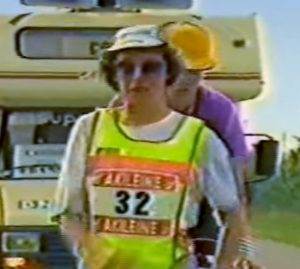

Richard was in 2nd place among the men but much further behind the leader and didn’t see Sandra start. He hoped to catch up by evening. But Richard struggled during his second day with dehydration and fatigue, falling into 8th place. On the second night walkers stopped for a mandatory 3-hour stop at about mile 166. Sandra’s required stop was shorter and she left before Richard arrived late into the night. He managed to get two hours of sleep and left the checkpoint around dawn. By mid-morning he was in 6th place and he was 18 miles behind Sandra. After 36 hours and about 125 miles, Sandra was in 2nd among the women as night arrived but suffered from bad blisters.
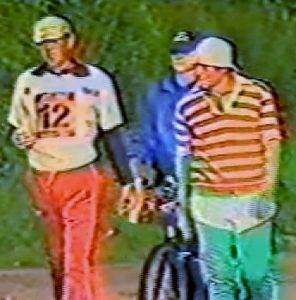



Later that night as Richard approached the finish he said, “I was sleep walking and hallucinating and had to be prevented from staggering to the right or the left by having crew members walking either side and giving me a gentle push back on course if I started to walk into the ditch.”
Richard did finish well and was greeted by a rested Sandra. Richard finished in 9th place with 73:29 for about 324 miles. They were the first husband and wife duo to finish this classic race. Sandra wrote, “Richard and I walked the Colmar road for the three years 1990-92. Although not seeking selection for ‘the big one’ after that, we continued to walk a number of selection races each year just for the pleasure of returning to walk these excellent events in France.”
By the end of 1990, Richard had piled up about 50 100+ milers and Sandra about 35.
Surgeres, France 48-hour
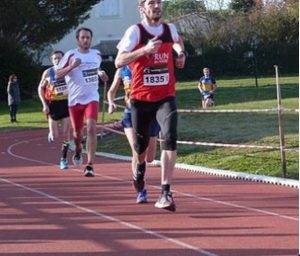

In 1985 a French runner, Jean-Gilles Boussiquet wished to establish a 48-hour record on a track in Surgeres, France. He found support from the community and friends who set up the event and finished with 207 miles. In 1986 eleven men and one woman ran in the first formal year of the race. Each year improvements were made and it soon became the premier 48-hour race in the world.
In 1991 Both Richard and Sandra competed at the famed race on the 300-meter track. Richard became the sixth man in history to go over 400k in a 48-hour race, reaching 401k (249 miles) for 3rd place overall, setting a British 48-hour record which still stood in 2018. Sandra ran 190 miles and placed 3rd among the women.
More Records
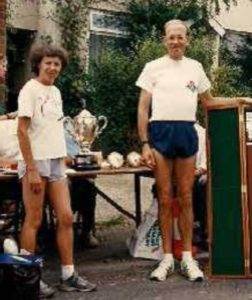

In 1991 Sandra set a women’s World Best Distance of 200km walk in 24:04:20 in Switzerland. In the same year she completed the historic Manchester to Blackpool 50-mile walk in 7:54:54. In 1996 she set a new women’s World Track Record time for 1000 miles in Australia.
Richard set British records for the 200km racewalk of 21:42 in 1992, the 100-mile racewalk of 16:50:28 in 1993, and the 48-hour indoor mark of 221 miles.
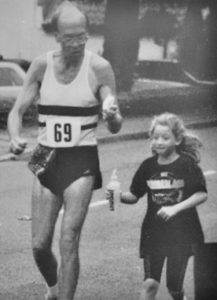

What about their young daughter, Victoria? She would come to certain events and help with support duties even as young as the age of five, handing out fluid bottles to her parents on the roadside.
Gibson Ranch 6-Day Classic
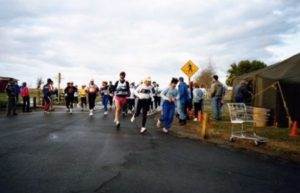

Some in the raced called Sandra “the clockwork doll” “You just wind her up and away she goes at a steady pace until she starts to run out of fuel. She then stops for a quick refill in the tent, gets back on the circuit and immediately round and round she goes again at the same old steady pace.” After the event the Kleins kindly took the Browns into their home until their return flight and helped them appreciate the beauty of the point-to-point Western States 100 which Norman was the race director of.
The Forrest Gump Run
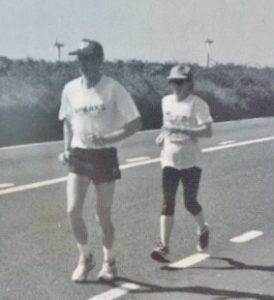

In 1995 both Richard and Sandra put together intense plans to both break the records for the LEJOG (Lands End to John O’Croats). Richard was convinced that he could shave off the wasted time incurred in 1985 to regain the record that Don Ritchie had snatched from him in 1989. Sanda wanted to break to official women’s record of 13 days 18:10. They chose May as their starting month to correspond with the release of the Forrest Gump movie in Britain. The film distributors help finance their attempt and they called their journey the Forrest Gump Run.
On the first day, Sandra went ahead walking faster. Richard would at times catch up explaining, “She was walking faster up the hills but was not able to run with such a long stride down them. She was well capable of getting to John O’Groats before me if she repeated her consistent ‘clockwork doll’ pattern with minimum sleep which had seen her complete the Gibson Ranch Six-Day Race so successfully.” Frequently a crew member on a bicycle would accompany them.
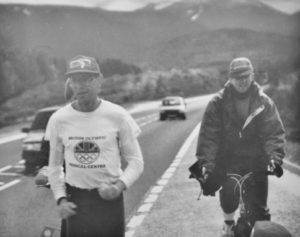

At about half way, Sandra was really suffering from painful feet and stomach issues. Her crew said, “We have gone over 400 miles. That’s tremendous. But look at your feet. We’ve still go another 400 miles to go. Be sensible.” Sandra’s response was just to put on her sandals, slowly get to her feet, and then she said calmly, “I’m going for a little walk. Would anyone care to join me?” On about the 7th day, Sandra collapsed after minimal sleep during that week. She was taken to a bath house and then slept for 8 hours before continuing.
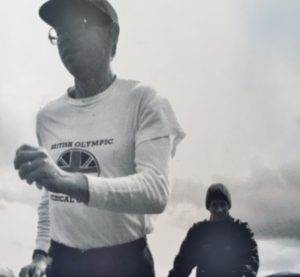

On about the 8th day, the record holder Don Ritchie kindly came to help support Richard for the day. His wife filmed at time and Richard tried his best to move well for the movie. Ritchie wrote, “Richard was in excellent spirits and walking strongly and aiming to cover 80 miles a day by combining running and fast walking. I cycled with him. The two vans worked in 4-hour shifts and Richard had an attendant walker or cyclist with him at all times. The on-duty van continually leap-frogged Richard so that they were never more than half a mile away. Richard would get out on the road by 4:14 a.m. and did not take a break until noon when he would take up to an hour break for lunch and then continued without a break until 11:30 p.m. He alternated race walking with running.” His walking pace was about 4.24-4.5 miles per hour.


Things continued to go well for Richard. Some cyclists who were trying to ride the LEJOG in ten days stopped to walk with Richard. They were stunned to learn that Richard was trying to also do it in about ten days on foot. Soon the end came near. Richard wrote, “We crested the last little hill and there before us lay the cluster of buildings by the edge of a calm blue sea dotted with islands. What a marvelous sight. My whole body and soul sighed. I touched the magic sign and a great cheer went up.” Richard had crushed the record by 13 hours and finished in 10 days, 2:25, a record that officially still stood in 2018. Three days later Sandra also touched the same post and broke the ladies record by nearly eight hours, finishing in 13 days, 10:01. She had walked all the way after the first day. Both traveled about 830 miles.
Brno Indoor 48 Hours
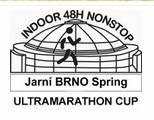



Richard recalled, “the upstairs circuit in the hall had some large glass sections. Since it was snowy and bitterly cold outside, you felt a weird range of temperature changes as you ran around. There was an exhibition going on down on the ground floor and occasionally people would pop their heads up the stairs to witness a strange collection of athletes running round in circles like hamsters.”


By the end of the 1990s, Richard had completed a world best 87 100+-milers and Sandra 82.
100 x 100
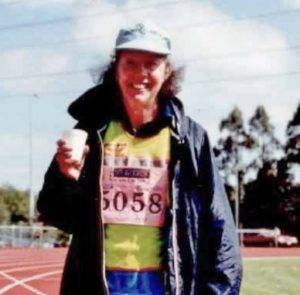

Richard reduced the number of 100+ mile races he finished each year but Sandra continued on with about five per year until she retired from work and then found time to increase the number of events she ran or walked.
Age Group Records
As they both reached toward their 60s, age-group British and world records were in their reach. In 2007 Richard (age 60) and Sandra (age 58) again ran at Surgeres 48 Hours in France. Sandra’s report included, “We enjoyed it very much, and combined the run with a couple of days holiday in that very nice part of Southwest France. We both did around 195km (121 miles) in the first 24 hours. Richard was starting to suffer a knee problem even then, but walked on and had to stop after a few more hours. I walked on steadily. I finished with [203 miles] and was very pleased to go over 200 miles. It’s a Great Britain W55 best. Walking (and a bit of running) 48 hours was surprisingly enjoyable. As always, runners are fascinated to see what walkers can do!”
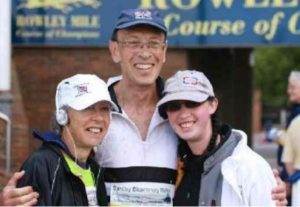

Sandra also collected many world age group records at various distances including a W60 100-mile roadwalk record at Newmarket, England of 19:57:24 in 2009 that was performed in a seven-hour downpour of rain during the night. She won the race outright and Richard placed second. Sandra also set a W60 24 hour road running record of 116 miles.


In 2010 Richard set a new M60 World 6 Day record of 437 miles set in Athens, Greece. Sandra wrote, “Richard is just back from setting a M60 road best performance for 6 days in Athens (where races up to 1000 miles were held in parallel). His 705kms was a great achievement given heat, strong winds and the usual challenges of surviving more or less intact for 6 days!”
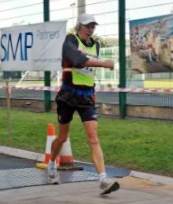

In 2012, Richard set an M65 World 6 Day record of 406 miles in Balatonfured, Hungary. That year Sandra achieved her 150th 100+ miler.
In 2013 at the age of 64, Sandra clocked a sub-20-hour 100-miler during a racewalk centurion event on the Isle of Man with a time of 19:57:50, coming in first among the women.
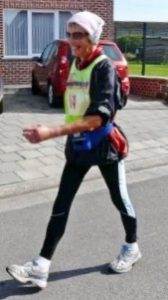

When Sandra turned 65 her world age group record collection continued to increase. In 2014 at the age of 65 at Southend on Sea, she walked 100-miles on a track in 20:40:32 for a world age group record and place 2nd overall.
Later that month she traveled to Belgium to walk in a 24-hour race. The report included, “In the women’s race, Sandra Brown and Corinne Fauqueur staged a great battle before Sandra finally broke clear to win, only a few weeks after her victory in the British Centurion qualifying event.” Sandra reached 118 miles and set a world age group record for walking 24 hours.
Coaching


For about ten years Richard served as the team manager of the British Ultramarathon team. The men’s team became World Champions in 2015 at Turin, Italy, and the women won the bronze. Richard achieved perhaps his greatest success as a team manager in 2016 when his runner, Dan Lawson, achieved 162 miles in 24 hours to become the individual European Champion. Richard wrote in 2016, “I have really enjoyed putting any experience I have back into the sport as the Manager of Team Great Britain’s 24 hour running squads for the past the past 10 years.”
Richards approach to racing and setting records was to walk or run steady paces. “If you are going for a record, then I think you have to go as steady and as even-paced as possible. You need to think, ‘this is a long race, I have got to keep it steady. I must no blow up.’”
In running ultras, Richard would recommend to ultrarunners he coached to walk at least five minutes every hour. He said that “running generally shortens your muscles while walking stretches them and you use different muscles. Running uses the quads more and walking uses the hamstring more. If you can walk reasonably fast you won’t lose much distance. With this approach you would usually ‘come through the field’ as you climb the standings. For the very long distances such as 48-hours, six days, fast walking is the key.”
He once said, “You don’t know what you are capable of achieving, but it is much more than you think. So set yourself an objective, celebrate the achievement and then set your sights higher.”
Africa Centurion


Sandra wrote: “This was a unique and amazing event, and a great feat of vision and organization to hold the event involving around 100 participants plus about 100 volunteers on this island, with its iconic history,10kms off the South African coast. I enjoyed the whole experience hugely, and found the Robben Island environment and history both inspiring and moving. I was very pleased to finish the 100 in 22.22.14 to achieve my 7th Centurion affiliation world-wide. The event was quite challenging in some respects, for example the weather was quite hot on Saturday, and very windy for most of the event. The night was also long and dark, and one needed the head-torch.”
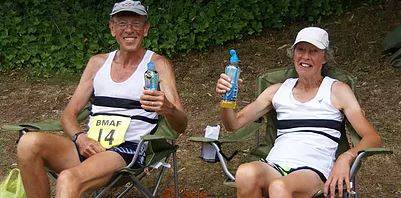

Amazing Careers
Summing up both their walking/running careers thus far is an impossible task. Here are just some of their accomplishments as of the end of 2018.
Sandra:
- was the first person in history to reach 100×100.
- has finished the most 100+ milers ever (200+).
- is the only person in the world to be awarded all seven Centurion medals from the seven Centurion clubs.
- has finished the most British Centurion races in the world in under 24 hours with 33.
- has finished 30 Centurion races in less than 20 hours.
- has finished 54 Centurion events, a world best.
- has reached 100 miles in less than 24 hours about 160 times, a world best
- has reached 100 miles in less than 20 hours about 45 times.
- still holds the World Walking Records on track for 100k, 100 miles, 12 hours, and 24 hours.
Richard:
- holds the best ever British 100-mile walk time of 16:50:28.
- was the sixth man in history to go over 400 kilometers in a 48-hour race.
- held the British record in the 6-day running 517 miles.
- held the 48-hour indoor record of 221 miles.
- still holds the world record in the 1000 km run in the age class M45.
- was the overall winner of a record 10 British Centurion races.
- has at least 110 sub-24-hour 100s
- has about 50 sub-20-hour 100s, perhaps a world best
Both Richard and Sandra are published authors, contributing to many newsletters and published books. See Unbroken Contact: One Hundred Years of Walking with Surrey Walking Club 1899-1999 by Sandra Brown, The Winning Experience: Winning in Sport, in Business, in Life by Richard Brown, and Long At The Top: Richard and Sandra Brown 1982-1993 by Dudley Harris
When Richard was asked if he and Sandra would retire from walking/running his reply was, “We will keep doing this until we drop. We would go mad if we stopped.”
200th 100-miler
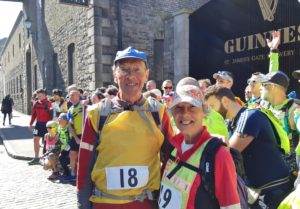

By the end of July, 2021, Sandra had accumulated 208 100+ finishes. The pandemic had paused her continued 100 quest. Here 208 list comprised of 87 fixed-distance events of 100+ miles or greater, 105 events of 24/28-hour events, and 16 multi-day events.
Read More Ultrarunning History articles
Sources:
- Long distance walking | The Ultra Browns
- The Australia Centurions
- Timothy Erickson “Sandra’s Hundreds”
- Timothy Erickson “Sandra Brown – 176 Hundreds”
- Timothy Erickson “Richard Brown – Ultra Walker, Ultra Runner”
- Timothy Erickson “Sandra Brown Ultra Record”
- Timothy Erickson, Centurion Footnotes Newsletters
- Richard Brown Oral History
- Richard Brown, The Winning Experience: Winning in Sport, in Business, in Life
- Don Ritchie, The Stubborn Scotsman
- The Victorian Race Walking Club
- The Long Distance Walkers Association
- Race Walking Association
- DUV – Ultra Marathon Statistics
- 1990 Paris Colmar – Mad Frogs and Englishmen Video
- Centurions 1911
- United States Centurion Walkers
- Davy Crockett Swift Endurance Legends – The Fastest 100-Mile Ultrarunners During the 1970’s, 80’s and 90’s
- Ohio Racewalker newsletters
- Isle of Man Race Walk
- International Association of Ultarunners
- “World Records and Best Performances, Women’s Race Walking”
